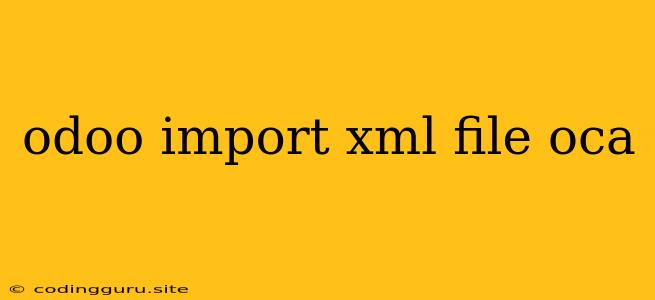Importing XML Files into Odoo: A Comprehensive Guide with OCA Resources
Odoo is a powerful open-source ERP system that offers a wide range of features and functionalities. One of its key strengths is its ability to handle data efficiently, and a common way to import data into Odoo is through XML files. This approach is particularly useful when you're setting up a new Odoo instance, migrating data from another system, or updating your existing data.
Why Use XML Files for Importing Data into Odoo?
XML (Extensible Markup Language) is a versatile format that's widely used for data exchange. In the context of Odoo, XML files are ideal for importing data because:
- Structured and Standardized: XML files provide a structured and standardized format for representing data. This ensures that data is organized logically and can be easily processed by Odoo.
- Human-Readable and Machine-Readable: XML files are both human-readable and machine-readable. This makes it easier to understand and validate the data before importing it.
- Flexibility: XML files offer flexibility in terms of data structure and can be easily adapted to different data models.
- Widely Supported: XML is a widely supported format, making it compatible with various tools and technologies.
How to Import XML Files into Odoo
The process of importing XML files into Odoo involves the following steps:
- Prepare the XML file:
- Ensure that your XML file follows the correct Odoo data structure.
- The XML file must be in the format that Odoo expects. The format is based on Odoo's database structure.
- You can use various tools and libraries to generate XML files for Odoo.
- Upload the XML file:
- Access the Odoo interface and navigate to the specific module or model where you want to import the data.
- Typically, there will be an option to "Import Data" or "Load Data" within the module settings.
- Choose the XML file you want to import.
- Configure import options:
- Depending on the module and the complexity of the import, there might be options to configure the import process.
- This might include settings related to data mapping, error handling, and data validation.
- Start the import process:
- Once you've configured the options, click on the "Import" or "Load" button to initiate the import process.
- Odoo will process the XML file and import the data into the corresponding module and records.
Finding XML Data Files for Odoo
You can find various resources and communities that provide pre-built XML files for common Odoo modules. Here are some excellent sources:
- OCA (Odoo Community Association): is a highly active and valuable resource for Odoo users. It hosts a wide range of Odoo modules developed by the community, including many that provide pre-built XML files for data import.
- Odoo Forums: The Odoo forums are a great place to connect with other Odoo users and find answers to specific questions.
- GitHub: Many developers share their Odoo modules and XML data files on GitHub. You can search for specific modules or data types on GitHub to find relevant resources.
Tips for Successful XML Import
Here are some tips to ensure a smooth and successful XML import into Odoo:
- Validate your XML file: Before you import your XML file, it's essential to validate it to ensure that it's well-formed and adheres to the Odoo data structure. This will help you catch any errors early and prevent potential import problems.
- Test the import on a test environment: It's always a good practice to test the import process on a test environment before performing it on your production system. This allows you to identify and resolve any issues without affecting your live data.
- Use the correct module and data model: Make sure that your XML file is compatible with the target module and data model in Odoo.
- Handle duplicate data: If you're importing data that might already exist in Odoo, configure the import settings to handle duplicates appropriately. This could involve updating existing records or creating new ones depending on your needs.
Troubleshooting XML Import Issues
If you encounter problems while importing XML files into Odoo, here are some common troubleshooting steps:
- Check the XML file: Verify that the XML file is well-formed and follows the Odoo data structure. Check for syntax errors, invalid data types, or missing fields.
- Check the data mapping: Ensure that the data fields in your XML file map correctly to the corresponding fields in the Odoo database.
- Check the import options: Review the import settings and ensure they are correctly configured for your specific needs.
- Check for Odoo errors: Odoo logs errors and warnings during the import process. Check the Odoo logs for any messages that might provide insights into the problem.
- Consult the Odoo documentation: Refer to the Odoo documentation for guidance on importing XML files and troubleshooting common issues.
Example of an XML File for Odoo
Here is a basic example of an XML file structure for importing data into the Odoo product.product model:
Product 1
100
PROD-001
Product 2
200
PROD-002
Conclusion
Importing XML files into Odoo is a powerful and efficient way to manage your data. By understanding the process, following best practices, and utilizing resources from the OCA and other communities, you can successfully import data and leverage the full potential of Odoo's capabilities. Remember to always validate your data, test on a test environment, and consult the Odoo documentation for further guidance.
